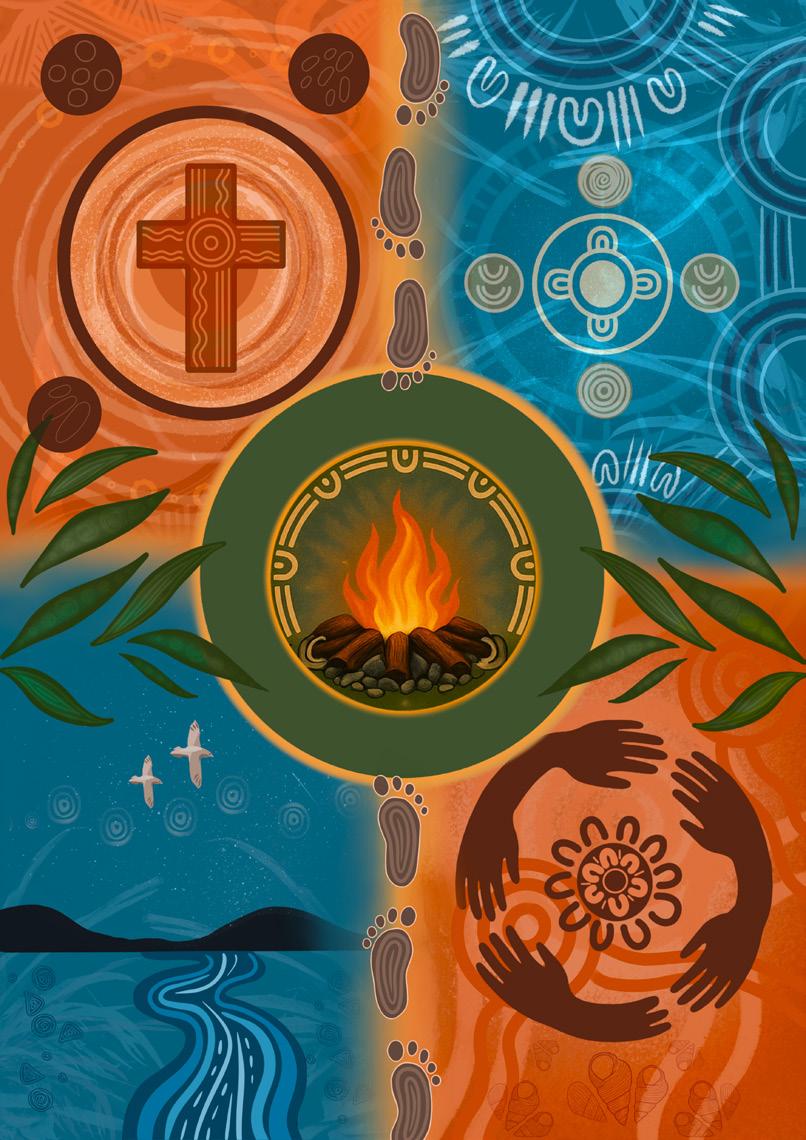
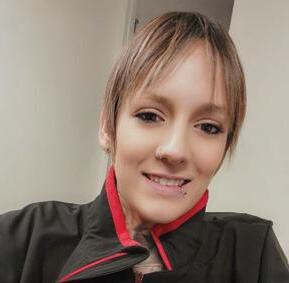



Grace Williams
Grace Williams is the Cultural and Community Resource Officer for Leprena UAICC Tasmania. She is a proud palawa woman from the South-East nations of lutrawita with professional exposure locally, state-wide and nationally.
This digital artwork is a powerful expression of the relationship between First and Second Peoples, grounded in shared values of truth, unity, and cultural strength. Centered around a fire circle — a sacred place of gathering, healing, and storytelling — the work invites reflection on the importance of connection, dialogue, and walking together with integrity. Rich in symbolism, the piece weaves elements of land, spirit, and community. Gumleaves offer protection and ceremony, while recurring motifs like footprints and meeting places reflect journeys across Country and the strength found in relationship. Gathered by Fire, Bound by Faith is a visual call to come together, honour Country, and continue building a future rooted in respect, truth, and shared purpose.
Published: 2025
Author: Tim Molineux
Contact: Timothy.Molineux@victas.uca.org.au
Authorised: Uniting Church Synod of Victoria and Tasmania, Walking Together in Covenanting Committee
Document Review Date: 2027
Available: https://victas.uca.org.au/resources/covenanting/



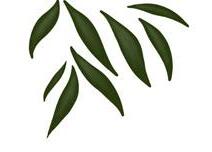
Whether you or your community of faith are new to Covenanting in the Uniting Church, or have been walking this path for years, this Toolkit is a great way to connect and reconnect with Covenanting practices.
This resource is not an exhaustive list of what you can do, and invites you to consider new opportunities for practical engagement with First Nation communities. There are additional resources available if you would like to know more about the Covenant and Covenanting in the Uniting Church, and to help explain why it is important theologically.
A Covenanting Guide and a series of FAQ sheets developed along with this resource are also available to encourage and inform you along your journey. This Toolkit was designed primarily as a digital resource, and contains extensive hyperlinks to take you to other resources from both inside and outside of the Uniting Church.
Covenanting is a special call to all Uniting Church members to form meaningful relationships between First and Second peoples based on truth-telling, justice, equality and mutual understanding. As Christians, our faith informs our lives. Therefore, Covenanting can, and should, holistically inform our faith and our relationships
between First and Second peoples, both within and outside of the Church.
However, while people outside of the Uniting Church are unlikely to know what Covenanting is, you can use Covenanting and this toolkit to help guide your own pathway to an understanding of truth, justice and reconciliation as a disciple of Jesus.
When seeking opportunities to connect with First Nations Communities, please be mindful that resourcing and connecting with non-Indigenous people (Second Peoples) is not the first priority for a lot of Aboriginal communities. While it may be disappointing to not receive an immediate or affirming response from a First Nations community to well-meaning invitation, please don’t take it personally, as Traditional Owner groups and Indigenous organisations already have plenty of demands for their time.
By design, this Toolkit is not a checklist to be completed in full, and instead contains multiple indirect and direct points of entry to do Covenanting with the hope you will
find one, or some pathways, that will be suitable for your own context.
• Do you know the Traditional Owners of the land where you live, work and worship? Page 7
• Have you ever participated in a Walking on Country? Page 9
• What Indigenous organisations, business and community groups are in your area? Page 11
• Are you familiar with, or worried about protocols for engaging with Aboriginal and Torres Strait Islander Peoples? Page 13
• Does your Congregation regularly practice an Acknowledgement of Country? Page 14
• What ways do you participate in justice and advocacy for First Peoples within the Uniting Church? Page 15
• Do you know important calendar dates for the relationships between First and Second Peoples? Page 17
• Where can you access additional Uniting Church Covenanting Resources? Page 18
• Have you heard about the elected Aboriginal and Torres Strait Islander People’s representative body in Victoria called the First Peoples’ Assembly of Victoria? Page 19

This Toolkit uses the language conventions of First Nations, First Peoples, Aboriginal and Indigenous contextually. Aboriginal and Indigenous is used interchangeably. However, best practice is to show respect of sovereignty by acknowledging First Nation peoples by naming a known community directly. In Victoria, for example: Bangarang and the Yorta Yorta from along the Murray River, Ladji Ladji near Mildura. Gunditjmara, and Kerrupjmara from the Western Districts. Gunai Kurnai from the Gippsland way. Watha Wurrung from Geelong. Widjubaluk from the desert country around the Dimboola area. Wemba Wemba from south of Swan Hill. Daung Wurrung from the Seymour area, and Dja Dja Wurrung from Bendigo. The traditional sovereignty of Melbourne belongs to the Wurundjeri and the Bunurong, two of the five nations that make up the Kulin Nation. More generally, across Victoria and New South Wales, Aboriginal people are known as Koori. From Tasmania (lutruwita), the community is generally known as Palawa or Pakana, however any of the nine cultural groups may individually use different naming conventions.

this Toolkit
Covenanting is as much a personal journey as it is for an entire congregation or community. Covenanting is the theologically informed Walking Together and healing of First and Second Peoples in the life of the Uniting Church.
This Walking Together, or journey, is lived out in how we as the People of God express our faithful witness to the gospel, and is an intentional response to our missional call to discern how to be a just and uniquely Australian church on colonised land.
As the Church, this witness to Covenanting has revealed important lessons on how the presence of God was understood to exist in the land prior to colonisation. It has also taught understandings of First Nations Sovereignty, and the resilience of First Nations Peoples in the face of past and continuing injustice. These lessons have informed our biblical interpretation of reconciliation in Australia, and helped facilitate a healing of the people and land by unlearning false truths about colonisation originally used to justify forced settlement and invasion.
This resource is a Toolkit for Covenanting in Victoria and Tasmania, and a way to further deepen you and your Congregation’s journey. Remember to celebrate the journey so far, and to honour the courage to be willing to discern new pathways for continued growth and renewal.
The Uniting Church has walked a long and often complicated path on its Covenanting journey. The Uniting Church’s Revised Preamble to its Constitution and Regulations (Basis of Union) is a good place to start. Along the way, both First and Second peoples have learned from failure and success. Each congregation’s experience with Covenanting is different, and it’s important to truthfully position yourself on your journey, and to acknowledge that by being part of the Uniting Church we are all called to participate in Covenanting.
Use this Toolkit to get access to resources to better understand where opportunities exist to connect with First People Communities in Victoria and Tasmania. Or, perhaps use it to help assess your own understanding of Uniting Church practices that inform how Covenanting is embedded in the life of the church.
Keep an eye out for the ‘Go Deeper’ pop out boxes to explore Covenanting further, these are invitations to take further steps towards living out the Covenant between First and Second Peoples.


Consider forming a short-term or long-term Covenanting group to action some of the items in this Toolkit. You may also consider connecting with other congregations in your geographical area, be they ecumenical, Uniting Church or inter-faith.
Consider contacting already existing secular Reconciliation Groups in Victoria, or connect with Reconciliation Tasmania. You could also explore organisations designed for Second peoples like ANTaR Victoria who exist to help and educate other Second People.
Do you know who the Traditional Owners are for the places you live, work, and worship?
Land is deeply connected to the spiritual, physical, social and cultural wellbeing of Aboriginal and Torres Strait Islander Peoples. Attempting to understand what that means from the perspective of a non-Indigenous person is not easy, and can challenge western centric preconceived notions of how religion, culture, and family connections are understood.
There are many different First People groups, or Nations, that hold the traditions and knowledge of their community through a connection to the land. This connection is often referred to as Sovereignty. One way to identify the Aboriginal community who holds a formally recognised and unbroken connection to the land you are on is to seek out groups known as Traditional Owners1 .
Traditional Owner organisations are formal bodies representing a specific First Nations community, and

usually exercise rights of native title over a defined land area. They are also the official community representative bodies that local, state and federal governments engage with.
Traditional Owner organisations often provide services such as cultural education, language and naming, land management, welcome to country, and reconciliation consultation. These are unique services only the community can provide, and payment is appropriate to compensate elders and community members for their time, and serves as a sign of respect for imparting knowledge.
Use this interactive map to find out who the Traditional Owners of the land you are on in Victoria are.2
Consider contacting a Traditional Owner organisation and making arrangements to have an elder to speak to the Congregation about their lived experience and the history of your local area, or to provide a ‘Welcome to Country’ for a Church event.
1 Depending on the community and context, it is sometimes more appropriate to say ‘Traditional Custodians’ instead of owners when referring to caring and looking after land and country. In the context of this resource, Traditional Owners refers to the legal status of Traditional Owner organisations with associated native title interests recognised by Government. Under Australian law, the government does not create native title, it only recognises where it already exists (Native Title Act 1993).
2 Or visit https://achris.vic.gov.au/weave/wca.html
There are currently 12 Traditional Owner groups1 formally recognised by the Government that cover 77.5% of the State. They are:
• Barengi Gadjin Land Council Aboriginal Corporation
• Bunurong Land Council Aboriginal Corporation
• Dja Dja Wurrung Clans Aboriginal Corporation
• Eastern Maar Aboriginal Corporation
• First People of the Millewa-Mallee
Aboriginal Corporation
• Gunaikurnai Land and Waters Aboriginal Corporation
• Gunditj Mirring Traditional Owners Aboriginal Corporation
• Taungurung Land and Waters Council Aboriginal Corporation
• Wadawurrung Traditional Owners Aboriginal Corporation
• Wamba Wemba Aboriginal Corporation
• Wurundjeri Woi-wurrung Cultural Heritage Aboriginal Corporation
• Yorta Yorta Nation Aboriginal Corporation

A map of the Traditional Owner Groups in Victoria is available online. It’s a great resource to print out and put up in your church to acknowledge the Traditional Owners of the land.
Tasmanian Aboriginal communities today are resilient, and continue to live on their country as they maintain and reclaim culture, language and identity. The First Peoples of Tasmania, or lutruwita2, are arguably the most impacted Aboriginal community in Australia through a brutal violent colonial period known as ‘the Black Wars´ (1823-1831). While Aboriginal communities exist in Tasmania, there are no groups formally recognised by the Australian Government as having the same Native Title status as those on the mainland. However, it is important to know that land is held on trust by the Aboriginal Land Council of Tasmania for the benefit of the nine Aboriginal groups, and for all Aboriginal people in Tasmania.
Resources are available online to learn more about the First Nation Peoples of Tasmania . You can also engage with cultural awareness organisations like mina nina
Use this interactive map to help you identify First Nations place names across Tasmania.3
1 There are three ways Traditional Owners of a particular part of country become formally recognised; Registered Aboriginal Party under the Aboriginal Heritage Act 2006, Native title determination under the Native Title Act 1993 (Cth), and Recognition and Settlement Agreement under the Traditional Owner Settlement Act 2010.
2 The naming convention for lutruwita (Tasmania) is to not capitalise it, and to spell it with a lower case ‘l’.
3 Or visit https://tacinc.com.au/pk/GIS/index.html#8/-41.953/146.342
There are both free and paid Aboriginal Community operated cultural walks and experiences across Victoria and Tasmania that you can engage with.
A paid Walking on Country experience will allow you to learn directly from an Aboriginal community, while also being an intentional act of honouring and supporting the contribution that Indigenous knowledge and culture has to Australia and the world.
It is strongly recommended that you join a guided tour run by Traditional Owners groups. The experience immerses you in a cultural context that is appropriately facilitated in the right way. As you hear stories and learn, you may also find yourself unlearning things that have always been false, but were taught as truths to help legitimise the disposition of Aboriginal people from their land; for example, the lie that there has never been Aboriginal farming or land management in Australia.
There are a number of Aboriginal cultural walking trails and public spaces for you to visit where you can appropriately be on country and immerse yourself and learn from this land’s living First Peoples’ culture. Below are websites listing various opportunities to Walk on Country, but be sure to do your own common-sense check for who created and operates the walk, for what purpose, and which community benefits from it. Two well-known Walking on Country opportunities are ‘Budj Bim’ and ‘Wukalina Walk’.
Budj Bim Cultural Landscape – In South-West Victoria there is an Aboriginal place with global significance. Called Budj Bim (Big Head), it is located within Gunditjmara traditional lands1 which is a UNESCO World Heritage protected site. Budj Bim is
You can find many different types of Aboriginal business that you can support. One nationally known business is ‘Clothing the Gaps’ which is an advocacy and Aboriginal Social Enterprise that retails to both Indigenous and nonIndigenous communities.
1 The Traditional Owner organisation is the Gunditj Mirring Traditional Owners Aboriginal Corporation




a volcano that erupted 30,000 years ago, and from at least 6,600 years ago (much older than the Great Pyramids of Giza), there has been a complex and permanent aquaculture network carved into the landscape to divert water and create holding ponds for kooyang (short-finned Australia eels).
All of the Budj Bim Cultural Landscape is Aboriginal owned and/or managed to respect the customary and legal rights and obligations of the Gunditjimara Traditional Owners. Budj Bim has a cultural centre open to the public, with a number of cultural tours on offer.
Find other Victorian Walking on Country opportunities:
• Koorie Heritage Trust
• Aboriginal Melbourne
• Deadly Stor y
• Visit Victoria
• Wurundjeri Walking Tours
• Yalinguth Walking Tour (Fitzroy)
wukalina Walk - The wukalina Walk is a renowned Palawa owned and led 4-day walking trail. After gathering in Launceston, the guided tours go through the coastline of wukalina (Mt William National Park) and Larapuna (Bay of Fires). The tour goes into the history of the land and the people, but also ties it to the contemporary lives of Palawa today which is a story of resilience and self-determination. Completing the wukalina walk is a way to expand your understanding and appreciation of Palawa culture and community.
Other Tasmanian Walking on Country opportunities:
• Discover Tasmania
• Blak Tours

What Indigenous organisations, business and community groups are in your area?
Connecting with Aboriginal and Torres Strait Islander Communities:
There are Aboriginal communities all around Victoria and Tasmania. And it’s easier than you might think to connect and support Aboriginal and Torres Strait Islander communities in your local area. These communities are often diverse, and are represented by community organisations supporting Traditional Owners, Stolen Generation survivors, businesses, social justice and political activism, cultural centres, youth, and health services.
A simple online search will help you find many First Peoples community organisations and businesses. Social media is a great way to connect with a community directly, and to find public events to attend and support.
Aboriginal Community Organisations regularly host community events which are usually open to the general public, or they may be solely for the benefit of the Aboriginal community which they serve. The distinction is often advertised, but you can make contact with the hosting organisation to find out more details.
Some Victorian Aboriginal Community Organisations are:
• First People’s Assembly of Victoria –Statewide
• Barrbunin Beek Aboriginal Gathering Place – Heidelberg
• Casey Aboriginal Gathering Place – Casey
• Mullum Mullum Indigenous Gathering Place – Croydon
• Nairm Marr Djambana – Frankston


Did you know the First Peoples community in the Uniting Church is called the Uniting Aboriginal and Islander Christian Congress (UAICC or Congress)?

• Wathaurong Booln Booln Cultural Centre – Geelong
• Whittlesea Local Aboriginal Network – Whittlesea
• Willum Warrain Aboriginal Association – Mornington Peninsula
• Koorie Heritage Trust – Melbourne
Some Tasmanian Aboriginal Community Organisations are:
• Leprena Tasmania (Uniting Church/UAICC) - Kingston
• Circular Head Aboriginal CorporationSmithton
• Melaythenner Teeackana Warrana (Heart of Country) Aboriginal Corporation (MTWAC) – Launceston
You can also listen to 3KND online or frequency 1503AM, which is Melbourne’s only Indigenous radio station.
Identify a First People community event that you or your congregation can support by simply attending, partnering with, volunteering at, or donating to. If you want to support Aboriginal people, then simply turn up when there’s an open invitation, rather than relying on Aboriginal people to accept an invitation to come to you.
1 Wathaurong Booln Booln Cultural Centre was formally called ‘ Wathaurong Co-op formally taking it over in 2024. Narana means ‘deep listening and understanding’. The new cultural centre is aiming to re-open in 2025.




Are you familiar with, or worried about protocols for engaging with Aboriginal and Torres Strait Islander Peoples?
Forming new relationships can be daunting when there are perceived cultural differences that sometimes feel like barriers. This can prevent us asking the important questions that would otherwise enable the building of bridges and the dismantling of walls that divide communities.
These questions might be around history, language and terminology, culture, and identity.
If you have questions around the appropriate way to engage with Aboriginal and Torres Strait Islander Peoples, there are extensive resources available that may answer the questions you have, and give useful examples of best practice. The two resources below were designed primarily for practitioners engaging directly with Aboriginal communities, but will likely hold answers to some of the more sophisticated questions you may have beyond what this Covenanting Pathways Toolkit offers.
Victorian Public Sector Commission – Aboriginal and/or Torres Strait Islander Cultural Capability Toolkit
This document supports public sector workplaces to build their capability to support and develop
Aboriginal staff at all levels. Its aim is to strengthen the cultural capability, as well as the cultural safety of public sector workplaces for Aboriginal employees. It discusses key concepts and understandings of Aboriginal culture and cultural capability.
Australia – Aboriginal and Torres Strait Islander Cultural Protocols
This document provides guidance within a not-forprofit context for staff and volunteers engaging with Aboriginal and Torres Strait Islander communities. The protocols are built on ethical principles of Human Rights to improve working relationships, and ensure community control over Indigenous culture and intellectual property.
You Can’t Say That: But Consider this… –University of Wollongong
This document goes into detail about language and its power, especially when it comes to racism. It was originally designed to be a terminology guide, but was re-published in the wake of the failed 2023 Voice to Parliament referendum which saw mistruths and racism used to undermine the process. The document’s purpose is to help educate people by learning best practice, and unlearning harmful mistruths.


Does your Congregation regularly practice an Acknowledgements of County?
Giving an Acknowledgement of Country at the beginning of a gathering is an important way to pay respect to the First Peoples of this land and to honour their Sovereignty. For Christians, we also do this as it’s an act of justice and healing, as an expression of biblically informed reconciliation. To begin, it’s important to know if there are formally recognised Traditional Owners of the land where you intend to give an Acknowledgement of Country and name them.
To find out who the Traditional Owners are where you are located, take a look at the “Do you know who the Traditional Owners are for the places you live, work, and worship?” section of this toolkit for some useful resources to help you find out. If you still aren’t sure who the Traditional Owners are, its ok to say “Traditional Owners” or “First Peoples” in your acknowledgement instead.
Did you know that the 15th Uniting Church Assembly in 2017 affirmed Aboriginal and Torres Strait Islanders as the Sovereign Peoples of this land? The Uniting Church’s own understanding of First Peoples’
It’s important to know the difference between an Acknowledgement of Country and a Welcome to Country. An Acknowledgement of Country can be said by anyone, and a Welcome to Country can only be offered by a First Nations person who is also a recognised member of the Traditional Owner community of the land where it will be spoken. One way to help understand this rule is to consider why your neighbour simply can’t welcome and let anyone they feel like into your home without your permission. This would be considered a serious breach of protocol, and the law of the land.
The Uniting Church has a useful resource that goes further into explaining why Acknowledgements of Country are important, and offers examples on how to do it.
You can explore this further in their guide, Acknowledgement of First Peoples in the Uniting Church in Australia Practices & Protocols


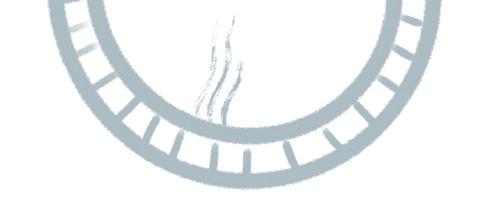
What ways do you participate in justice and advocacy for First Peoples within the Uniting Church?
A large part of Covenanting requires taking personal responsibility to become aware of the lived experiences of First Peoples, and understanding the obligations of Second Peoples who are all the historical beneficiaries of the colonisation of Australia. Some of the issues you will come across include matters of judicial reform, Sovereignty, Aboriginal deaths in custody, protecting sacred sites, racism and Closing the Gap between First and Second Peoples. Support comes in many forms, and can take the
participating in reconciliation Australia campaigns, party based political activism, and grass roots community mobilisation.
The first step is always to listen, and hear what the Indigenous community has to say on matters that are impacting them.
In all forms of justice and advocacy for First Peoples, it’s important that the voice of Aboriginal people come first. The Uniting Church strives to embody this belief,




Do you know important calendar dates for the relationships between First and Second Peoples?
A great way to engage with Covenanting throughout the year is to incorporate important dates into your Congregation’s event calendar and lectionary to intentionally reflect and learn. These dates are interwoven with celebration, commemoration and lament. There are days to remember trauma, harm and conflict, but also to honour and reflect upon the resilience and strength of First Nation peoples in the face of injustice.
Some key dates the Uniting Church observes annually are:
January: Day of Mourning
(First Sunday before Invasion Day/Australia Day –25th January)
On the Sunday before Australia Day, Uniting Church congregations across the country hold worship services to reflect upon and lament the invasion and colonisation of this nation, and the effect upon its First Peoples. The observance of a ‘Day of Mourning’ was endorsed by the 15th Assembly at the request of members of the Uniting Aboriginal and Islander Christian Congress (UAICC).
27 May – 3 June:
The week begins on 27 May to mark the 1967 Referendum, and ends on 3 June to mark Mabo Day. This week reflects on shared histories, contributions and achievements between First and Second peoples. It is a forward-looking time to build relationships between Aboriginal and Torres Strait Islander people and other peoples in Australia.
July: NAIDOC Week
(First full week of July, Sunday to Sunday)
NAIDOC (National Aboriginal and Islander Day Observance Committee) week celebrates Aboriginal and Torres Strait Islander cultures and recognises the contributions of Indigenous Australians. Its origins stem from Aboriginal groups in the 1920s which sought to increase awareness of the status and treatment of Indigenous Australians.

10 July: Uniting Church Covenant between First and Second Peoples, and Revised Preamble Statements were read between the President of the Uniting Church and the UAICC National Chairperson at the Uniting Church’s 7th Assembly in 1994. This marked the beginning of an intentional relationship between First and Second Peoples in the Uniting
Did you know that Covenanting and Reconciliation have a lot in common, but mean different things depending on the context? There are resources to learn more.

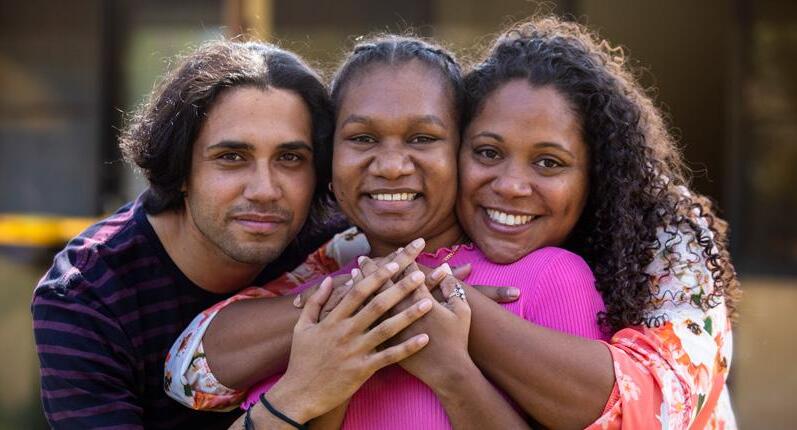
Where can you access additional Uniting Church Covenanting Resources?
There are a series of Convenanting resources designed to accompany this toolkit that are available:
• FAQ Uniting Aboriginal and Islander Christian Congress
• FAQ Covenant and Covenanting
• FAQ Covenanting and Reconciliation
• FAQ Revised Preamble to the Uniting Church Constitution (Basis of Union)
• Cultural Calendar
Over its many years of Covenanting between First and Second peoples, a range of resources have been developed by the Uniting Church for individuals,
The Uniting Church Assembly can arrange a Covenanting Banner congregation that name Traditional Owners of the land you are on.

Resources & Next Steps
Have you heard about the elected Aboriginal and Torres Strait Islander People’s representative body in Victoria called the First Peoples’ Assembly of Victoria?
With bipartisan support in August 2018, the State Parliament of Victoria enacted the Advancing the Treaty Process with Aboriginal Victorians Act 2018 This historic piece of legislation paved the way for the formation of the First Peoples Assembly of Victoria as part of the State’s aspiration to have Australia’s first treaty with First Peoples. The First Peoples Assembly of Victoria is an independent and democratically elected body representing Traditional Owners of Country, and Aboriginal and Torres Strait Islanders in Victoria. It is comprised of 32 Aboriginal and Torres Strait Islanders people in Victoria. Each of the formally recognised Traditional Owner groups are allocated one seat each, with the remaining seats being democratically elected seats that are split across six geographical regions.
To learn more, visit the First Peoples’ Assembly of Victoria official website

The formal process of negotiating what will be included in a Statewide Treaty officially began on 21 November 2024. The legislation that is guiding Victoria’s pathway towards treaty purposefully does not specify exhaustively who the treaty will be with, nor does it spell out what can and cannot be included within it. The silence on these issues allows for self-determination so different Aboriginal groups that want their own treaty can negotiate for themselves. The approach means there is scope for more than one treaty to be negotiated.
Did you know that the telling to form part of the preferred pathway toward a fair and more truthful account of Australia’s history?



The independent body responsible for overseeing the treaty negotiations process is the Treaty Authority. While not party to the negotiations itself, the Treaty Authority handles any dispute resolution, and makes sure all negotiating parties follow the rules for treaty making that have been agreed to.
To learn more, visit the Treaty Authority official website
Another important part of this process in Victoria has been truth-telling, which led to the formation of the Yoorrook Justice Commission. The Commission is the first of its kind in Australia, and has the full powers of a royal commission. It is a formal truth-telling process into historical and ongoing injustices experienced by First Peoples in Victoria. The Commission is led by five commissioners, four of whom are Aboriginal. The Commission’s final report is due in 2025.
To learn more, visit the Yoorrook Justice Commission official website.
The Victorian Treaty Process so far:
• March 2016 – the Labor Dan Andrews Government commits to discussing a treaty process.
• July 2016 – The Aboriginal Treaty Working Group was formed.
• 2017 – The Aboriginal Community Assembly was formed, and the Victorian Treaty Advancement Commission was created to consult with the community.
• August 2018 — Advancing the Treaty Process with Aboriginal Victorians Act 2018 passed with bipartisan support in the Victorian Parliament.
• 2019—The First Peoples’ Assembly of Victoria, an independent and democratically elected body to represent Traditional Owners of Country and Aboriginal and Torres Strait Islander peoples in Victoria, is formed. The Assembly is the First Nations representative body negotiating treaties with the Victorian Government.

• 2020 – The First People’s Assembly calls for a truth and justice process, and the Victorian Government works with the Assembly to design a framework.
• 2021—The Yoorrook Truth Telling Commission is formed, investigating several areas of historical and current injustice that have impacted First Peoples in Victoria. The Commission’s final report is due in June 2025.




Website: victas.uca.org.au